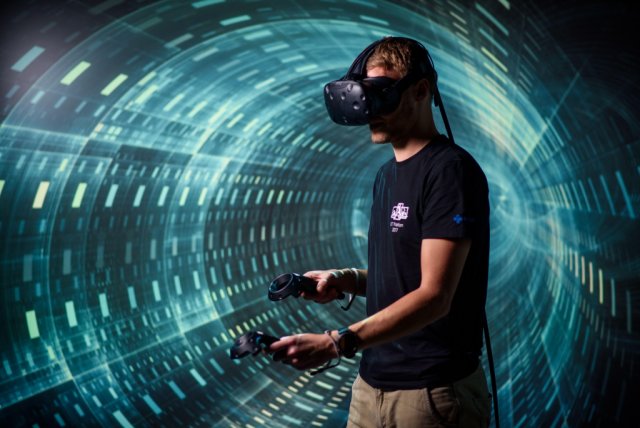Virtual Reality Lab has several headsets HTC Vive for virtual reality (VR). It is a mobile VR set with interactive elements for manipulating objects in VR using a very precise "tracking" technology. The big advantage of these sets is their compact size and the ability to present them almost anywhere. FEM HUBRU uses these sets, for example, for marketing purposes and promotion of the faculty. Using the Neos VR Metaverse Engine technology from Solirax, it is possible to have a walk through the 3D model of the faculty part. There you can find interesting information about study fields, enjoy the 360° photo gallery (the user is literally immersed in the photo) or you can play the latest faculty videos or reportages.
Using the programming tool called LogiX, there can be created interactive elements within the given environment that promote interactivity with user and provide a relatively new trend of gamification. Marketing through virtual reality is becoming more attractive to the general public.

In addition to the marketing use, the VR sets serve to study the support of the decision-making process. In decision-making process, for example in spatial planning, are often involved multiple actors from different disciplines and occupations. Meetings are held, where different visual tools are used. The big problem is that the tools and imaging are understood only by experts from the given areas. The informations in this presented form, are to the laymen (very often they have a major role during the decision-making process) almost incomprehensible. Three-dimensional view mode (3D) has been proven to be a fast and effective tool in decision making with fewer errors. Participants in the decision-making process are able, trough the virtual reality, to better and easier understand the given issue and better orientate in it. In the area of spatial planning, they can, within the virtual reality, have a walk through the future-built buildings, parks, check the engineering networks, etc.
The pilot project is the virtual model of the Multipurpose hall in the DOX Center of Contemporary Art. It is a model of the currently unfinished hall, which will host various cultural events in the future. The needed variability of the hall usage puts great emphasis for the distribution of audio, video, controls and, last but not least, the possibilities of moving the mobile tribune. The basis for creating a "virtual walk" was to create 3D objects (supplied by the company AVT Group) based on real parameters (building plans, existing devices, etc.) that were inserted into the VR scene. Subsequently, the scene and some key features for "virtual walkers" (possibility to pull down the console for audio-video, interactive light control, and move the mobile tribune) were set. Whole scene manipulation and feature setups were performed using tools for development directly within the VR scene. The participant (architect, client, contractor, etc.) can have a virtual walk through the finished building, try out how effective the distribution of audiovisual elements will be, what space the console will occupy in the pull-down state (its service) and how the hall will be set for different cultural events. This "virtual walk" possibility serves not only to identify potential problems and to eliminate or adjust the deployment of elements, but also to present the hall that is not yet built.
Future development of the lab will involve the implementation of a new develop environment common to headset and CAVE and Augmented Reality technology.





